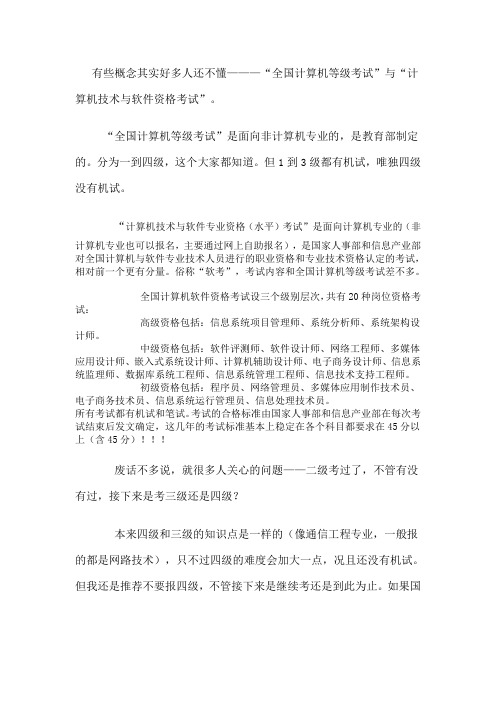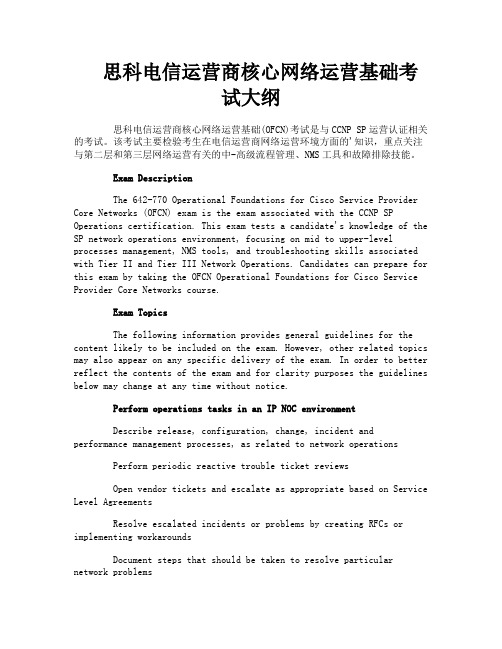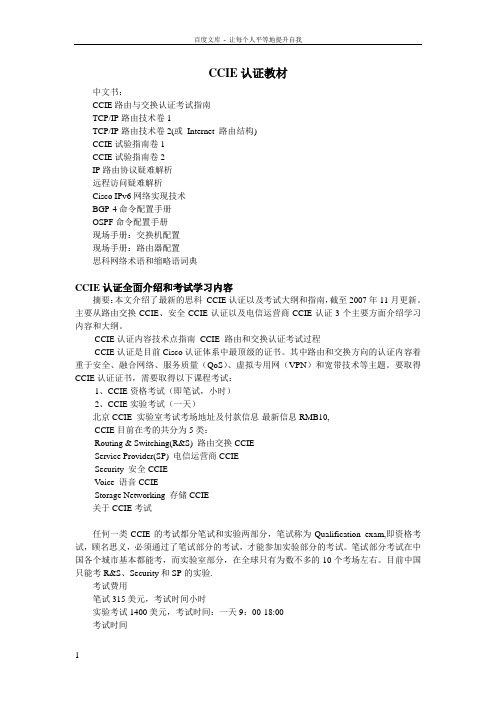CCIE SP3.0(运营商CCIE)考试大纲
全国计算机等级考试与计算机技术与软件专业资格(水平)考试

有些概念其实好多人还不懂———“全国计算机等级考试”与“计算机技术与软件资格考试”。
“全国计算机等级考试”是面向非计算机专业的,是教育部制定的。
分为一到四级,这个大家都知道。
但1到3级都有机试,唯独四级没有机试。
“计算机技术与软件专业资格(水平)考试”是面向计算机专业的(非计算机专业也可以报名,主要通过网上自助报名),是国家人事部和信息产业部对全国计算机与软件专业技术人员进行的职业资格和专业技术资格认定的考试,相对前一个更有分量。
俗称“软考”,考试内容和全国计算机等级考试差不多。
全国计算机软件资格考试设三个级别层次,共有20种岗位资格考试:高级资格包括:信息系统项目管理师、系统分析师、系统架构设计师。
中级资格包括:软件评测师、软件设计师、网络工程师、多媒体应用设计师、嵌入式系统设计师、计算机辅助设计师、电子商务设计师、信息系统监理师、数据库系统工程师、信息系统管理工程师、信息技术支持工程师。
初级资格包括:程序员、网络管理员、多媒体应用制作技术员、电子商务技术员、信息系统运行管理员、信息处理技术员。
所有考试都有机试和笔试。
考试的合格标准由国家人事部和信息产业部在每次考试结束后发文确定,这几年的考试标准基本上稳定在各个科目都要求在45分以上(含45分)!!!废话不多说,就很多人关心的问题——二级考过了,不管有没有过,接下来是考三级还是四级?本来四级和三级的知识点是一样的(像通信工程专业,一般报的都是网路技术),只不过四级的难度会加大一点,况且还没有机试。
但我还是推荐不要报四级,不管接下来是继续考还是到此为止。
如果国家三级过了(其实过三级主要还是靠死背知识点,难度到不是那么难),接下来再考的话,我建议有两个方向。
1、去考“软考”的网络工程师,这无疑更有价值。
因为四级网络工程师只有一张卷子,考试时间120分钟。
事实上软考整体比全国等级考试影响大得多。
软考从80年代中期就开始办了;而等级考试晚了10年,影响限于高校内。
思科电信运营商核心网络运营基础考试大纲

思科电信运营商核心网络运营基础考试大纲思科电信运营商核心网络运营基础(OFCN)考试是与CCNP SP运营认证相关的考试。
该考试主要检验考生在电信运营商网络运营环境方面的'知识,重点关注与第二层和第三层网络运营有关的中-高级流程管理、NMS工具和故障排除技能。
Exam DescriptionThe 642-770 Operational Foundations for Cisco Service Provider Core Networks (OFCN) exam is the exam associated with the CCNP SP Operations certification. This exam tests a candidate's knowledge of the SP network operations environment, focusing on mid to upper-level processes management, NMS tools, and troubleshooting skills associated with Tier II and Tier III Network Operations. Candidates can prepare for this exam by taking the OFCN Operational Foundations for Cisco Service Provider Core Networks course.Exam TopicsThe following information provides general guidelines for the content likely to be included on the exam. However, other related topics may also appear on any specific delivery of the exam. In order to better reflect the contents of the exam and for clarity purposes the guidelines below may change at any time without notice.Perform operations tasks in an IP NOC environmentDescribe release, configuration, change, incident and performance management processes, as related to network operationsPerform periodic reactive trouble ticket reviewsOpen vendor tickets and escalate as appropriate based on Service Level AgreementsResolve escalated incidents or problems by creating RFCs or implementing workaroundsDocument steps that should be taken to resolve particular network problemsDefine proactive problem management and root cause analysistools and methodsPlan, coordinate, and support network upgrades and changesIdentify the methods used to perform proactive network maintenanceInterpret performance and incident reports and recommend actions for problem avoidanceTroubleshoot an IP NOC environmentDescribe network troubleshooting methodologiesIdentify information needed to troubleshoot problemsIdentify and categorize network incidents based on the OSI modelTroubleshoot complex core network faultsTroubleshoot transport layer and network access technologies to the aggregation edgeIsolate problems using standard TCP/IP IPv4 and IPv6 toolsIdentify the most probable cause of a problem based on troubleshooting test outputTroubleshoot network service issues and its interoperability with OSS platforms within the core networkUse protocol analysis and packet decode tools to diagnose and troubleshoot network issuesInterpret XML messages and protocol without the use of NMSOperate network equipment in an IP NOC environment using Cisco IOS XRDescribe differences between Cisco IOS and Cisco IOS XR SoftwareIdentify standard XR CLI commandsIdentify Cisco IOS XR software architecture and featuresInterpret and deploy basic XR configurationsDescribe process of downloading and installing new software and Software Maintenance Upgrades (SMU) for Cisco IOS XR SoftwareManage network configurations in an IP NOC environmentIdentify global configuration templatesEnsure that device configurations comply with global configuration templatesCreate device specific configuration templatesInterpret and edit scripts that support process automationIdentify daily preventative maintenance tasks for network operationsManage the change process an IP NOC environment using Change Management proceduresIdentify the planning elements of a core network RFCIdentify and update logical and physical documentation impacted by change management RFCsReview and approve network related changes to the networkIdentify network improvement opportunities from periodic change metricsIdentify RFC MOP elements that support a managed network changeIdentify methods used to perform Cisco IOS and Cisco IOS XR software and hardware upgrades, downgrades, or replacementsImplement planned Cisco IOS and Cisco IOS XR software and hardware configuration changes to a core networkVerify implementation of Cisco IOS and Cisco IOS XR software and hardware changesIdentify impacts of network changes to related processes and systemsManage IP network performance in core and aggregation components in an IP NOC environmentIdentify network faults and capacity planning utilizing performance dataIdentify network capacity and performance using key performance indicator (KPI) dataIdentify key performance indicators at the network, device and service levelsIdentify baselining and its value in capacity and performance managementIdentify improvement opportunities and issues in traffic patterns and thresholds using alarms and network dataDetermine appropriate actions to resolve performance or capacity issuesIdentify causes of threshold crossing alertsIdentify methods and tools used to predict network capacity issues。
思科认证考试

报考条件
凡具有DOS、Windows和一定英语水平的在职人员、各大专院校在校学生及要求获得络关键设备技术知识的人 员均可报名参加Cisco培训。通过国际认证考试可获得Cisco国际认证证书。
报名时间
考生必须提前3天和考管员确定考试时间。
考试时间
思科认证的考试内容包括笔试和实验。笔试在全球认证的考试中心进行,时间为两个小时。由于采用了计算 机联的标准化考试,因此考试一结束,学员马上就可以知道自己的成绩。实验考试只限于思科在全世界范围内指 定的6个考点,分别位于美国、澳大利亚、比利时、日本、北京的新世纪饭店以及香港。实验室考试分为2天,第 一天要求学生利用实验室提供的设备建立络。第二天由考官故意破坏学员的络,学员则要想办法查出故障并加以 解决。
谢谢观看
Cisco考试的变化都会在其官方站上提前通知。Cisco考试时间和报名时间都是即报即考(CCIE考试除外), 没有固定的时间安排。参加Cisco考试直接到当地城市的VUE考试中心报名参加即可!
Cisco重考规定:参加Cisco考试如果一次未通过隔五天方可再参加此门考试的重考。
考试费用
基于Cisco的机考认证考试价格范围是从80美元至325美元或等值的其他货币。 ICND1(640-822ICND1)和ICND2(640-816ICND2)考试费用为150美元 CCNA路由与交换(640-802CCNA)考试费用为295美元 CCDA(640-864DESGN)考试费用为200美元 CCNA(单科)考试费用为250美元 CCIE和CCDE的笔试费用为350美元。 CCIE实验考试费用为¥人民币。 以上思科考试费的付款方式是直接向授权的合作伙伴PearsonVUE交付考试费用(CCIE实验考试除外,其付款 方式是通过在线信用卡或电汇交付)。
思科认证网络工程师CCNA安全认证考试大纲

思科认证网络工程师CCNA平安认证考试大纲CA平安认证可满足那些负责网络平安的IT专业人员的需求。
它表示通过认证的专业人士拥有相应的专业技能,可以胜任网络平安专家、网络平安管理员和网络平安支持工程师等职位。
该认证所验证的技能包括:在保持数据和设备的完好性、保密性和可用性的条件下安装、故障排除和监控网络设备,以及使用思科在平安架构中所采用的技术进展开发的才能。
施行思科网络平安210-260 IINS考试时间为90分钟,考生需要完成60-70到考题。
210-260 IINS考试验证考生是否具备网络平安架构,理解网络平安核心概念,管理平安访问,加密,防火墙,平安入侵防御,网页及邮件内容平安及终端设备平安等知识。
通过210-260 IINS考试证明考生拥有在思科平安网络架构中施行操作的才能。
考生可以通过参加施行思科网络平安(IINS)课程来准备参加考试。
1.1 Common security principles1.1.a Describe confidentiality, integrity, availability (CIA)1.1.b Describe SIEM technology1.1.c Identify mon security terms1.1.d Identify mon work security zones1.2 Common security threats1.2.a Identify mon work attacks1.2.b Describe social engineering1.2.c Identify malware1.2.d Classify the vectors of data loss/exfiltration1.3 Cryptography concepts1.3.a Describe key exchange1.3.b Describe hash algorithm1.3.c Compare and contrast symmetric and asymmetric encryption1.3.d Describe digital signatures, certificates, and PKI1.4 Describe work topologies1.4.a Campus area work (CAN)1.4.b Cloud, wide area work (WAN)1.4.c Data center1.4.d Small office/home office (SOHO)1.4.e Network security for a virtual environment2.1 Secure management2.1.a Compare in-band and out-of band2.1.b Configure secure work management2.1.c Configure and verify secure aess through SNMP v3 using an ACL2.1.d Configure and verify security for NTP2.1.e Use SCP for file transfer2.2 AAA concepts2.2.a Describe RADIUS and TACACS+ technologies2.2.b Configure administrative aess on a Cisco router using TACACS+2.2.c Verify connectivity on a Cisco router to a TACACS+ server2.2.d Explain the integration of Active Directory with AAA2.2.e Describe authentication and authorization using ACS and ISE2.3 802.1X authentication2.3.a Identify the functions 802.1X ponents2.4 BYOD2.4.a Describe the BYOD architecture framework2.4.b Describe the function of mobile device management (MDM)3.1 concepts3.1.a Describe IPsec protocols and delivery modes (IKE, ESP, AH, tunnel mode, transport mode)3.1.b Describe hairpinning, split tunneling, always-on, NAT traversal3.2 Remote aess3.2.a Implement basic clientless SSL using ASDM3.2.b Verify clientless connection3.2.c Implement basic AnyConnect SSL using ASDM3.2.d Verify AnyConnect connection3.2.e Identify endpoint posture assessment3.3 Site-to-site3.3.a Implement an IPsec site-to-site with pre-shared key authentication on Cisco routers and ASA firewalls3.3.b Verify an IPsec site-to-site4.1 Security on Cisco routers4.1.a Configure multiple privilege levels4.1.b Configure Cisco IOS role-based CLI aess4.1.c Implement Cisco IOS resilient configuration4.2 Securing routing protocols4.2.a Implement routing update authentication on OSPF4.3 Securing the control plane4.3.a Explain the function of control plane policing4.4 Common Layer 2 attacks4.4.a Describe STP attacks4.4.b Describe ARP spoofing4.4.c Describe MAC spoofing4.4.d Describe CAM table (MAC address table) overflows4.4.e Describe CDP/LLDP reconnaissance4.4.f Describe VLAN hopping4.4.g Describe DHCP spoofing4.5 Mitigation procedures4.5.a Implement DHCP snooping4.5.b Implement Dynamic ARP Inspection4.5.c Implement port security4.5.d Describe BPDU guard, root guard, loop guard4.5.e Verify mitigation procedures4.6 VLAN security4.6.a Describe the security implications of a PVLAN4.6.b Describe the security implications of a native VLAN5.1 Describe operational strengths and weaknesses of the different firewall technologies5.1.a Proxy firewalls5.1.b Application firewall5.1.c Personal firewall5.2 Compare stateful vs. stateless firewalls5.2.a Operations5.2.b Function of the state table5.3 Implement NAT on Cisco ASA 9.x5.3.a Static5.3.b Dynamic5.3.c PAT5.3.d Policy NAT5.3 e Verify NAT operations5.4 Implement zone-based firewall5.4.a Zone to zone5.4.b Self zone5.5 Firewall features on the Cisco Adaptive Security Appliance (ASA) 9.x5.5.a Configure ASA aess management5.5.b Configure security aess policies5.5.c Configure Cisco ASA interface security levels5.5.d Configure default Cisco Modular Policy Framework (MPF)5.5.e Describe modes of deployment (routed firewall, transparent firewall)5.5.f Describe methods of implementing highavailability5.5.g Describe security contexts5.5.h Describe firewall services6.1 Describe IPS deployment considerations6.1.a Network-based IPS vs. host-based IPS6.1.b Modes of deployment (inline, promiscuous - SPAN, tap)6.1.c Placement (positioning of the IPS within the work)6.1.d False positives, false negatives, true positives, true negatives6.2 Describe IPS technologies6.2.a Rules/signatures6.2.b Detection/signature engines6.2.c Trigger actions/responses (drop, reset, block, alert, monitor/log, shun)6.2.d Blacklist (static and dynamic)7.1 Describe mitigation technology for email-based threats7.1.a SPAM filtering, anti-malware filtering, DLP, blacklisting, email encryption7.2 Describe mitigation technology for web-based threats7.2.a Local and cloud-based web proxies7.2.b Blacklisting, URL filtering, malware scanning, URL categorization, web application filtering, TLS/SSL decryption7.3 Describe mitigation technology for endpoint threats7.3.a Anti-virus/anti-malware7.3.b Personal firewall/HIPS7.3.c Hardware/software encryption of local data。
CCIE认证教材

CCIE认证教材中文书:CCIE路由与交换认证考试指南TCP/IP路由技术卷1TCP/IP路由技术卷2(或Internet 路由结构)CCIE试验指南卷1CCIE试验指南卷2IP路由协议疑难解析远程访问疑难解析Cisco IPv6网络实现技术BGP-4命令配置手册OSPF命令配置手册现场手册:交换机配置现场手册:路由器配置思科网络术语和缩略语词典CCIE认证全面介绍和考试学习内容摘要:本文介绍了最新的思科CCIE认证以及考试大纲和指南,截至2007年11月更新。
主要从路由交换CCIE、安全CCIE认证以及电信运营商CCIE认证3个主要方面介绍学习内容和大纲。
CCIE认证内容技术点指南CCIE 路由和交换认证考试过程CCIE认证是目前Cisco认证体系中最顶级的证书。
其中路由和交换方向的认证内容着重于安全、融合网络、服务质量(QoS)、虚拟专用网(VPN)和宽带技术等主题。
要取得CCIE认证证书,需要取得以下课程考试:1、CCIE资格考试(即笔试,小时)2、CCIE实验考试(一天)北京CCIE 实验室考试考场地址及付款信息-最新信息RMB10,CCIE目前在考的共分为5类:Routing & Switching(R&S) 路由交换CCIEService Provider(SP) 电信运营商CCIESecurity 安全CCIEV oice 语音CCIEStorage Networking 存储CCIE关于CCIE考试任何一类CCIE的考试都分笔试和实验两部分,笔试称为Qualification exam,即资格考试,顾名思义,必须通过了笔试部分的考试,才能参加实验部分的考试。
笔试部分考试在中国各个城市基本都能考,而实验室部分,在全球只有为数不多的10个考场左右。
目前中国只能考R&S、Security和SP的实验.考试费用笔试315美元,考试时间小时实验考试1400美元,考试时间:一天9:00-18:00考试时间笔试任意时间,由考生自定实验考试需提前预定考试地点笔试在VUE指定思科考试中心报考;誉天是湖北唯一CISCO考试中心。
ccie考试内容(一)

ccie考试内容(一)CCIE考试内容介绍CCIE(Cisco Certified Internetwork Expert)认证是全球认可的网络技术专家认证之一。
它考察的内容广泛,包括网络设计、部署、优化和支持等方面。
本文将介绍CCIE考试的内容及相关要点。
考试科目CCIE考试涉及多个科目,主要包括以下几个方面:1.网络基础知识:包括网络协议、数据链路层、网络层、传输层等基础知识。
考生需了解TCP/IP协议、路由协议以及网络拓扑等内容。
2.网络设计与架构:考察网络设计的原则、方法和技巧。
考生需要熟悉网络架构设计、安全设计以及负载均衡等相关知识。
3.网络支持与运维:涉及网络故障诊断与恢复、性能优化以及网络监控等内容。
考生需要了解网络故障排除的方法和工具,能够分析和解决网络故障。
4.网络安全:考察网络安全的基础知识、技术和实践。
考生需了解防火墙、入侵检测与防御、加密传输等安全相关的内容。
5.网络服务与应用:涉及网络应用和服务的部署与管理。
考生需要了解常见应用协议、服务提供商的网络服务以及流量管理等。
考试要求CCIE考试要求考生具备以下能力:•掌握网络技术的基本概念和原理,具备深入的网络知识。
•具备网络架构设计和实施的能力,能够根据需求进行网络规划和设计。
•能够解决网络故障和问题,进行故障诊断和修复。
•具备网络安全实施和管理的能力,能够保护网络的安全性。
•了解网络服务和应用的部署与管理,能够提供高质量的网络服务。
考试准备为了顺利通过CCIE考试,考生需要:1.系统学习:全面系统地学习和巩固网络技术知识,包括网络原理、协议和设备等方面的内容。
2.实操训练:通过实际搭建和配置网络实验环境,进行实操训练,熟悉各种网络设备和技术的操作与应用。
3.模拟考试:参加模拟考试,检验自己的学习成果,找出不足之处并进行针对性的强化训练。
4.参考资料:查阅相关的教材、参考书籍和网络资源,获取更多的学习资料和案例。
总结CCIE考试是一个综合能力的考察,要求考生具备广泛的网络知识和技能。
思科认证考试

思科认证考试
在现代科技领域,网络技术的重要性愈发突出。
思科认证作为全球领先的网络
解决方案供应商,其认证考试备受广大技术从业人员的关注和追求。
通过思科认证考试,不仅可以证明个人在网络技术领域的专业知识和技能,还可以为个人职业发展打下坚实的基础。
思科认证的种类
思科认证从最基础的CCENT(思科认证入门级)到最高级的CCIE(思科认证
专家级),涵盖了广泛的网络技术领域。
其中,CCNA(思科认证中级)是许多从
业人员努力追求的目标,因为它标志着个人在网络领域的一定功底和认可度。
思科认证考试的内容
思科认证考试包括理论知识考核和实际操作考核两个部分。
理论知识考核主要
考察考生对网络技术的了解和掌握程度,而实际操作考核则更注重考生在实际网络环境下的应用能力和解决问题的能力。
思科认证考试的备考方法
备考思科认证考试,首先要全面复习网络技术相关知识,建立扎实的理论基础。
其次,需要通过实际操作来巩固知识,熟练掌握网络设备的配置和故障排查技能。
最后,参加模拟考试,对已学知识进行检验和总结,及时调整备考策略。
思科认证考试的意义
思科认证考试不仅仅是一份证书,更是对个人专业水平和技能的认可,是个人
职业发展的重要里程碑。
拥有思科认证可以为个人在就业市场中增加竞争力,为个人提供更多的发展机会和广阔的职业空间。
综上所述,思科认证考试是现代网络技术领域的重要一环,其意义远远超出一
份证书的价值。
通过认真备考和努力实践,每一位考生都有机会在思科认证考试中展现自己的技能和才华,为自己的职业生涯开辟更加美好的未来。
关于CCIE考试

本文由wuhuaishi126贡献
doc文档可能在WAP端浏览体验不佳。建议您优先选择TXT,或下载源文件到本机查看。
关于 CCIE 考试: 任何一类 CCIE 的考试都分笔试和实验两部分,笔试称为 Qualification exam,即资格考试,顾名思义,必须通过了笔试部分的考试,才能参加实验部分 的考试。笔试部分考试在中国各个城市基本都能考,而实验室部分,在全球只有 为数不多的 10 个考场左右。目前中国只能考 R&S 和 Security 的实验,今天只给 大家介绍 R&S 的,关于其它,以后再介绍。 准备笔试部分要看哪些书或做那些培训呢?如果是去培训中心上课的话, 一 般要上万人民币,所以要做好经济上的准备。 R&S CCIE 考试: 我推荐以下几本书: 如果你对 Cisco 路由器交换机技术还刚入门, 那么要先看下面的书或培训教 材: 1.<> (Interconnecting Cisco Network Devices,CCNA 培训教材) 2.<> (Building Scalable Cisco Internetworks,CCNP 路由培训教材, 前身是 BSCN) 3.<> (Building Cisco Multilayer Switched Networks,CCNP 交换课程培训教材) 4.<<CCIE Routing and Switching Exam Certification Guide>> (针对笔试用的 CiscoPress 官方书, 2002 年 8 月 7 日以后笔试考试更新后而出) 5.<<Routing TCP/IP, Volume I>> (IGP 知识点经典书) (作者 Jeff Doyel) 6.<> (EGP 知识点经典书) (作者 Halabi) 7.<<Cisco Lan Switching>>(交换基础书,但 99 年出版,技术有点老了,需补 充,作者 Kennedy Clark)
- 1、下载文档前请自行甄别文档内容的完整性,平台不提供额外的编辑、内容补充、找答案等附加服务。
- 2、"仅部分预览"的文档,不可在线预览部分如存在完整性等问题,可反馈申请退款(可完整预览的文档不适用该条件!)。
- 3、如文档侵犯您的权益,请联系客服反馈,我们会尽快为您处理(人工客服工作时间:9:00-18:30)。
CCIE 老版本SP2.0 考试v60++TOP样图CCIE ISP v3.0-Lab Equipment(2011年4月18日开始启用)• Cisco XR12000 Series Routers• Cisco 7200/7600 Series equivalent Routers (Using Simulator) • Cisco ME3400E Series SwitchesSoftware Versions• XR12000 routers running IOS-XR Software Version 3.9.1 • 7200/7600 routers running IOS Software Version 12.2-33 SR • ME3400E switches running IOS Software Version 12.2-54 SE IOS-XR will act as P and PE in lab, 7600 is using simulater in lab, there is no ES card, VPLS test on XR-12k.CCIE SP3.0将移除”面试环节”,将首次在SP考试中启用IPv6知识点!CCIE 运营商SP3.0考试详细大纲1. Implement, Optimize and Troubleshoot Core IP Technologies 1.1. Packet over SONET1.1.01. Cisco HDLC encapsulation1.1.02. PPP encapsulation1.1.03. Frame Relay encapsulation1.1.04. Maximum transmission unit (MTU)1.1.05. Cyclic redundancy check (CRC)1.1.06. Keepalive timer1.1.07. Frame Relay DLCI on point to point sub-interface1.1.08. SONET Controller1.1.09. POS channel1.1.10. Channelized SONET1.1.11. SONET APS1.2. IP over DWDM1.2.1. Optical channel payload unit (OPU)1.2.2. Optical channel data unit (ODU)1.2.3. Optical channel transport unit (OTU)1.2.4. Optical channel (OCh)1.2.5. Shared Risk Link Group (SRLG)1.2.6. Virtual Transponder (VTXP)1.2.7. FEC-FRR Triggering1.2.8. Optical Parameters- Rx-los-threshold, Wavelength and Transmit-power1.2.9. G.709 Parameters1.3. GE/10GE in the Core1.3.1. Gigabit Ethernet standards1.3.2. 10 Gigabit Ethernet standards1.3.3. Duplex mode1.3.4. MTU1.3.5. Flow control1.3.6. Link Aggregation Control Protocol (LACP)1.3.7. 802.1Q VLAN sub-interface1.4. SP high end product1.4.01. IOS-XR structure1.4.02. Install IOS-XR software1.4.03. Upgrade and manage IOS-XR software1.4.04. Secure domain router (SDR)1.4.05. CRS-1/3 structure1.4.06. CRS-1/3 Multi chassis1.4.07. Redundant Route Processors1.4.08. RP switchover1.4.09. MSC Architecture1.4.10. Switch Fabric Architecture1.5. IGP routing1.5.01. Network Service Access Point (NSAP)1.5.02. IS-IS Packet data unit (PDU)1.5.03. IS-IS hello1.5.04. IS-IS Link-state packets1.5.05. IS-IS Sequence Number Packets1.5.06. IS-IS area type1.5.07. IS-IS level1.5.08. IS-IS circuit type1.5.09. IS-IS Type Length Values (TLV)1.5.10. IS-IS Pseudo node1.5.11. IS-IS Designated Intermediate Systems 1.5.12. IS-IS SPF1.5.13. IS-IS LSP attached bit1.5.14. IS-IS LSP overload bit1.5.15. IS-IS Multi topology1.5.16. IS-IS Metric1.5.17. IS-IS support for IPv61.5.18. OSPF multi instance1.5.19. OSPF router-ID1.5.20. OSPF router type1.5.21. OSPF area1.5.22. OSPF hello1.5.23. OSPF LSA1.5.24. OSPF media type1.5.25. OSPF Designated Routers1.5.26. OSPF interface cost1.5.27. OSPF interface type1.5.28. OSPFv3 support for IPv61.5.29. EIGRP Diffusing Update Algorithm (DUAL) 1.5.30. EIGRP Composite Metrics1.5.31. EIGRP Hello1.5.32. EIGRP neighbor1.5.33. EIGRP Unequal Cost Load Sharing1.5.34. RIP v21.3.35. RIP support for IPv61.5.36. Redistribution between OSPF,IS-IS and EIGRP1.5.37. Redistribution of Directly connected routes1.5.38. Redistribution of Static routes1.5.39. Route summary1.5.40. IOS-XR routing policy language (RPL)1.5.41. Routing policy using route-map1.6. MPLS and LDP1.6.01. MPLS network component (P, PE, CE)1.6.02. MPLS label format1.6.03. MPLS label encapsulation1.6.04. MPLS label stack1.6.05. MPLS label operation1.6.06. Forwarding Equivalence Class1.6.07. Label Distribution Protocol (LDP)1.6.08. Label advisement model1.6.09. MPLS LDP—Local Label Allocation Filtering1.6.10. MPLS LDP-IGP synchronization1.6.11. MPLS LDP Inbound/outbound Label Binding Filtering1.6.12. Label Merging1.6.13. MPLS over ATM1.6.14. P2MP MPLS1.6.15. Multicast LDP(mLDP)1.7. MPLS Traffic Engineering1.7.01. TE Path calculation Constrained-Based Shortest Path First (CSPF)1.7.02. TE link information distribution1.7.03. RSVP support for TE path setup1.7.04. IS-IS support for TE1.7.05. OSPF support for TE1.7.06. Forwarding Traffic down Tunnel1.7.07. MPLS-TE Automatic Bandwidth1.7.08. MPLS-TE Static route1.7.09. MPLS-TE Auto route1.7.10. MPLS-TE Policy route1.7.11. MPLS-TE Forwarding adjacency1.7.12. MPLS-TE path metric1.7.13. MPLS-TE LSP attributes1.7.14. MPLS-TE Class-based Tunnel selection1.7.15. Pseudowire Tunnel Selection1.7.16. Point to multi point ( P2MP) MPLS TE1.7.17. Shared Risk Link Group (SRLG)1.7.18. Inter-Domain MPLS TE1.7.19. Inter-Area MPLS TE1.8. BGP1.8.01. BGP messages1.8.02. BGP neighbor1.8.03. BGP update1.8.04. BGP attributes1.8.05. BGP synchronization1.8.06. BGP routes aggregation1.8.07. BGP route reflector1.8.08. BGP confederation1.8.09. BGP Communites1.8.10. BGP Cluster list1.8.11. BGP Peer Groups1.8.12. IBGP IPv4/IPv6 Peering1.8.13. EBGP IPv4/IPv6 Peering1.8.14. EBGP IPv4/IPv6 multi hop peering1.8.15. BGP IPv4/IPv6 routes advertising1.8.16. EBGP IPv4/IPv6 peering using local-AS1.8.17. EBGP IPv4/IPv6 peering using AS-override1.8.18. BGP IPv4/IPv6 using private AS number1.8.19. Dual AS configuration for Network AS migration1.8.20. BGP Routing policy1.8.21. Redistributing IGP, static and connected route into BGP 1.8.22. BGP Multi-path Load Sharing1.8.23. BGP Link Bandwidth1.9. Multicast1.9.01.1 IPv4/IPv6 Multicast addressing1.9.01.2 Multicast distribution tree1.9.01.3 Multicast forwarding1.9.01.4 Multicast Reverse Path Forwarding (RPF)1.9.01.5 Multicast Administrative Boundaries1.9.01.6 PIM sparse mode for IPv4/IPv61.9.02. IPv4/IPv6 Multicast routing1.9.03. PIM Sparse Mode for IPv4/IPv61.9.04. IGMP V2/V31.9.05. IPV6 Multicast Listener Discover (MLD)1.9.06. PIM Source Specific Multicast (SSM) for IPv4/IPv61.9.07. Multicast Rate-limiting1.9.08. PIM Bidirectional (BiDir)1.9.09. PIM Static RP1.9.10. PIM Bootstrap Router (BSR)1.9.11. PIM Auto RP1.9.12. PIM Anycast RP1.9.13. Multicast Administrative Boundaries1.9.14. MSDP1.9.15. MP-BGP peer for Multicast1.9.16. MP-BGP Multicast route advertising1.9.17. Label switch multicast1.10. High Availability1.10.01. NSF/SSO for IGP routing1.10.02. NSF/SSO for BGP routing1.10.03. NSF/SSO for LDP, TE, Multicast1.10.04. HSRP, VRRP, GLBP1.10.05. Graceful Restart1.10.06. Control Plane Policing (CPP)1.10.07. Bidirectional forwarding detection (BFD)1.10.08. IP event dampening1.10.09. IGP Fast Re-route1.10.10. MPLS TE Fast Re-route (FRR)1.10.11. Link Protection using MPLS-TE1.10.12. Node Production using MPLS-TE1.10.13. Embedded event management (EEM)1.10.13. Hold-off Timer to Prevent Fast Reroute from Being Triggered (SONET)1.11. Convergence1.11.01. IS-IS fast convergence1.11.02. IS-IS to utilize the Overload Bit1.11.03. OSPF fast convergence1.11.04. BGP fast convergence1.11.05. BGP Route Dampening1.11.06. BGP Fast Peering Session Deactivation1.11.07. BGP Prefix Independent Convergence (PIC)1.11.08. BGP next hop tracking1.11.09. BGP address tracking filter1.11.10. BGP path MTU discovery1.11.11. IP fast reroute (IPFRR)1.11.12. Multicast-only Fast Re-Route (MoFRR)1.11.13. MPLS LDP convergence1.12. SP QoS1.12.01. Marking using DSCP, IP precedence and CoS1.12.02. Priority Queuing1.12.03. Custom Queuing1.12.04. Weighted Fair Queuing1.12.05. WRED1.12.06. Policing1.12.07. Class-based Weighted Faire Queuing (CB-WFQ) 1.12.08. Low-Latency Queuing (LLQ)1.12.09. Random-Detect using MQC1.12.10. NBAR for QoS1.12.11. MPLS EXP1.12.12. Differentiated Services Traffic Engineering (DS-TE) 1.12.13. Maximum Allocation Model (MAM)1.12.14. Russian Dolls Model (RDM)1.12.15. Class-Based Tunnel Selection: CBTS1.12.16. Policy-based Tunnel Selection: PBTS1.13. Security in core1.13.01. Standard Access-lists1.13.02. Extended Access-lists1.13.03. Routing Protocol Authentication for RIP V21.13.04. Routing Protocol Authentication for EIGRP1.13.05. Routing Protocol Authentication for OSPF1.13.06. Routing Protocol Authentication for IS-IS1.13.07. Routing Protocol Authentication for BGP1.13.08. BGP TTL Security Check1.13.09. Infrastructure ACL1.13.10. Anti Fragment Attacks1.13.11. Filtering RFC 1918 Routes1.13.12. uRPF for Anti-Spoofinng1.13.13. Selective packet discard (SPD)1.13.14. LDP authentication1.13.15. Remote triggered black hole (RTBH)1.13.16. NTP1.13.17. Attack mitigation1.13.18. SNMP Management1.13.19. IP packet Accounting1.13.20. Syslog2. Implement, Optimize and Troubleshoot Edge/Access Technologies2.1. FE/GE and Ethernet Trunk connections2.1.01. Ethernet Wire Service (EWS)2.1.02. Ethernet Relay Service (ERS)2.1.03. Ethernet Multipoint Service (EMS)2.1.04. Ethernet Flow Point (EFP)2.1.05. Ethernet Virtual Circuit (EVC)2.1.06. 802.1Q standard2.1.07. 802.1QinQ2.1.08. 802.1ad Provider Bridges (PB)2.1.09. 802.1ah Provider Backbone Bridge (PBB)2.1.10. Spanning Tree Protocol (STP)2.1.11. Resilient Ethernet Protocol (REP)2.1.12. Virtual Trunking Protocol (VTP)2.1.13. Flexible Service Mapping/Forwarding2.1.14. Ethernet Connectivity Fault Management (CFM)2.1.15. Ethernet channel2.2. PPP connections2.2.1. LCP2.2.2. NCP2.2.3. PPP encapsulation2.2.4. PPP multilink2.2.5. PPP Multi chassis multilink2.2.6. PPPoE client2.2.7. PPPoE server2.2.8. PPP authentication2.3. SONET/SDH connections2.3.1. SONET/SDH frame2.3.2. Automatic protection switching (APS), Timing2.3.3. Channelized SDH, channelized interface,2.4. Frame-relay connections2.4.1. Frame Relay PVC, SVC, DLCI2.4.2. Congestion-Control Mechanisms, FECN, BECN2.4.3. Discard Eligibility (DE) bit2.4.4. Frame Relay Fragmentation (FRF.12)2.4.5. Frame Relay FRF.9 Payload Compression2.4.6. Frame Relay Multilink (MLFR-FRF.16)2.4.7. Frame Relay Switching2.4.8. Frame-Relay LMI-Type2.4.9. PPP over Frame-Relay2.5. ATM connections2.5.1. ATM cell2.5.2. Virtual Path Identifier (VPI), Virtual Channel Identifier (VCI)2.5.3. Payload Type (PT), Cell Loss Priority (CLP)2.5.4. ATM adaptation layer (AAL)2.5.5. ATM addressing2.5.6. ATM PVC/SVC2.5.7. ATM Cell Loss Priority (CLP) Setting2.5.8. IP over ATM ( RFC1483)2.6. T1/T3 and E1/E3 services.2.6.1. Multiplexing2.6.2. Framing2.6.3. Timing2.6.4. Chanel group3. Describe, Implement, Optimize and Troubleshoot Remote Access Technologies3.1. IP over DSL to the customer3.1.1. PPPoA3.1.2. PPPoE over ATM3.1.3. L2TP between LAC and LNS3.1.4. RA (PPPoA,PPPoE over ATM) to VRF and MPLS VPN3.1.5. PPP authentication (Radius, TACACS)3.1.6. DHCP and options 823.2. IP over wire line to the customer3.2.1. PPP3.2.2. PPPoE3.2.3. L2TP between LAC and LNS3.2.4. PPPoE to VRF and MPLS VPN3.2.5. PPP authentication (Radius, TACACS)3.2.6. DHCP and options 823.2.7. Broadband network gateway (BNG)3.3. IP over Cable to the customer3.3.1. DOCSIS 3.03.3.2. PPPoE3.3.3. L2TP between LAC and LNS4. Implement, Optimize and Troubleshoot Layer 3 VPN4.1. Intra AS L3 MPLS VPN4.1.01. MP-IBGP VPNv4/VPNv6 peering4.1.02. MP-IBGP peering using loopback interface4.1.03. VPNv4/VPNv6 Route Reflector4.1.04. VRF definition4.1.05. Route Distinguisher4.1.06. Route Target4.1.07. Route Target import/export4.1.08. Intra AS MPLS VPNV4/VPNV6 load balancing4.1.09. SOO Community4.1.10. PE-CE – RIP V24.1.11. PE-CE – IS-IS4.1.12. PE-CE – OSPF4.1.13. PE-CE – EBGP4.1.14. PE-CE – Static Routes4.1.15. Redistributing dynamic PE-CE routes into VPNv4/VPNv6 4.1.16. Redistributing static PE-CE routes into VPNv4/VPNv64.1.17. Redistributing VPN4/VPNv6 routes into PE-CE routing table4.1.18. Intra-AS MPLS VPN multipath4.1.19. Intra-AS MPLS VPN path selection4.2. Inter AS L3 MPLS VPN4.2.1. MP-EBGP VPNv4/VPNv6 peering using direct interface4.2.2. MP-EBGP VPNv4/VPNv6 peer using multi-hop interface4.2.3. MP-EBGP VPNv4/VPNv6 peer between RRs4.2.4. VPNV4/VPNv6 next-hop unchanged4.2.5. VPNV4/VPNv6 next-hop self4.2.6. Multi VRF between ASPEs4.2.7. Inter-AS MPLS VPNV4/VPNv6 multipath4.2.8. Route target rewrite4.2.9. Inter-AS MPLS VPN path selection4.3. Carrier supporting carrier4.3.1. MPLS LDP in customer carrier site4.3.2. EBGPv4 + label between CSC-PE and CSC-CE4.3.3. IGP + LDP between CSC-PE and CSC-CE4.3.4. MPLS VPNv4 between customer carrier sites PEs4.3.5. CSC VPN load balancing4.3.6. VRF definition in customer carrier site4.3.7. Customer carrier site PE-CE routing4.4. VPN Extranet and internet access4.4.1. MP-BGP VPNv4/VPNv6 Extra-Net4.4.2. MP-BGP VPNv4/VPNv6 internet access4.5. VRF service4.5.1. Multiple VRF4.5.2. Multiple VRF routing4.5.3. VRF Selection based on Source IP Address4.6. Multicast VPN4.6.1. Default MDT4.6.2. Data MDT4.6.3. MP-BGP mdt peering4.6.4. Multicast routing in VPN site4.6.5. PM-SM in VPN site4.6.6. RP in VPN site4.6.7. Multicast VPN extranet4.7. GRE L3 VPN4.7.1. MPLS VPN—L3VPN over GRE5. Implement, Optimize and Troubleshoot Layer 2 VPN 5.1. Atom5.1.01. Psuedowire-class5.1.02. EoMPLS –Ethernet over MPLS5.1.03. FRoMPLS –Frame Relay over MPLS5.1.04. HDLCoMPLS-HDLC over MPLS5.1.05. PPPoMPLS-PPP over MPLS5.1.06. AAL5oMPLS-ATM AAL5 over MPLS5.1.07. L2TPv35.1.08. FR/PPP/HDLC/Ethernet interworking over MPLS 5.1.09. FR/PPP/HDLC/Ethernet interworking over L2TPv3 5.1.10. L2VPN local switching5.2. VPLS and Carrier Ethernet5.2.1. VPLS5.2.2. H-VPLS5.2.3. VFI definition5.2.4. VPLS BGP auto discovery5.2.5. VLAN attached circuit5.2.6. QinQ attached circuit5.2.7. 802.1ad attached circuit5.2.8. 802.1ah attached circuit5.2.9. VPLS/H-VPLS redundancy5.3. L2TPV3 for L2VPN5.3.1. L2TPv35.3.2. L2TPv3 VPN local switching5.3.3. L2TPv3 VPN interworking5.4. GRE L2VPN5.4.1. L2VPN over GRE6. Implement, Optimize and Troubleshoot Managed Services Traversing the Core6.1. Managed Voice/Video services traversing the core6.1.1. Traverse Voice/video packet6.1.2. Traverse call signal packet6.2. Managed Security services traversing the core6.2.1. Traverse IKE packet6.2.2. Traverse ESP, AH packet6.2.3. Traverse SSL packet6.3. Service Level Agreements for managed services6.3.1. IP SLA sender6.3.2. IP SLA responder6.3.3. IP SLA for MPLS VPN6.3.4. Netflow6.3.5. Netflow for MPLS6.3.6. Netflow for Multicast7. Describe Service Provider Network implementing principle7.1 Given a Service Provider network design change or new service, identify the success criteria7.2 Given a Service Provider network design change or new service, identify appropriate routing protocol7.3 Given a Service Provider network design change or new service, identify appropriate tunneling protocol7.4 Given a Service Provider network design change or new service, identify improving convergence method7.5 Given a Service Provider network design change or new service, identify improving stability method7.6 Given a Service Provider network design change or new service, identify improving reliability method7.7 Given a Service Provider network design change or new service, identify improving management method7.8 Given a Service Provider network design change or new service, identify improving QOS method7.9 Given a Service Provider network design change or new service, identify improving security。
